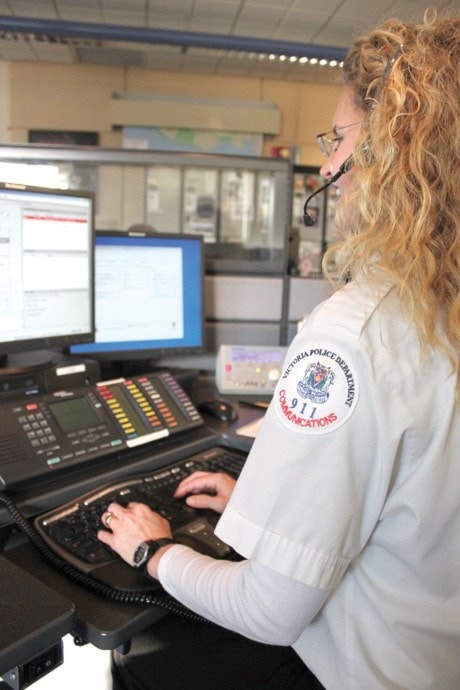Erin McCracken
News staff
C.C. the cat is sound asleep on a swivel chair inside the nerve centre of the Victoria Police Department, where 911 operators don’t have long to wait before their phones ring.
Like the relaxed 11-year-old former stray who lives at the department’s 911 communications centre, for which she is named, the centre’s 46 full- and part-time dispatchers, call-takers, trainers, switchboard operators and supervisors are always alert yet calm during a crisis.
“We deal with the worst but we also deal with the best – we also deal with heroes every day,” said Céline deGrasse, who has been a supervisor at the centre for three years, and before that worked as an operator/dispatcher since 1988.
Today, she is halfway through her 12-hour shift, which has been relatively quiet, though she prefers not to use that word.
“We’ll say it’s peaceful,” deGrasse said. “I hate to use the ‘Q’ word. It’ll jinx us.”
Friday and Saturday nights tend to be busy ones at the centre, which is open around the clock.
“We’ve had some Sunday nights that were just squirrelly,” she said.
Last year, 50,737 calls for service came into the communications centre, down from 53,695 calls in 2009, and 56,997 calls in 2008, according to the department’s 2010 annual report, which was released last week.
Of those, 3,621 were priority one or the most serious of calls, representing an increase by 119 over 2009, and a spike by 535 since 2008. These required immediate dispatch to a scene where there was a high probability of death or grievous bodily harm.
During each shift, a switchboard operator answers non-emergency calls, while call-takers answer emergency and non-emergency lines. Nearby, dispatchers direct emergency personnel to where they are needed most.
A third dispatch station was installed in November that can be manned during critical incidents or on special event days, such as on July 1, when a bevy of calls come into the centre and more officers than usual are on duty to manage downtown celebrations.
“It can be overload … having this operational is great,” said deGrasse.
The team works together to ensure 911 calls are answered within five seconds, or three rings.
“You have to be in tune with what’s going on in the room at all times,” deGrasse said.
“If the 911 (line) rings, you always have to be aware that if that rings more than a certain number of times, and you know what everyone else in the room is doing, and if you’re not doing something urgent, you have to pick up that call.”
Some of their time is soaked up by about 4,500 abandoned calls each year, in which a 911 call has been accidentally made from a cellphone in someone’s pocket, or a caller has hung up before connecting with an operator.
These still require a call-back to ensure assistance isn’t needed, deGrasse said.
Regardless of the type of call, staff must be unflappable, have compassion and empathy, and be able to quickly shift gears, such as during a high-priority medical-aid call involving serious injuries, for example, she explained.
“Boom, boom, boom, (police are) asking for all kinds of information, ambulance is asking for stuff,” deGrasse said. “You’re getting all this in the call and then you hang up when your part of the call is done, and then someone calls in complaining about a barking dog.
“You have to have the same amount of empathy and understanding for both those types of calls.”
Not everyone is drawn to working in such a demanding, fast-paced, every-changing environment, where can be a lot at stake, deGrasse said, adding that the work can also be very rewarding.
“It’s a different job ... and when you can help people, you get a sense of pride.”
VicPD’s online 2010 annual report, including crime trend data and crime statistics by neighbourhood, are available at vicpd.ca.
Report highlights
• Traffic offences (collisions, fatalities, impaired): 2,204, down from 2,251 in 2009
• Crimes against property (fraud, break and enter, theft, arson): 6,849, down from 6,968 in 2009
• Crimes against person (murder, assault, threats, robbery): 2,374, up from 2,247 in 2009
• Other Criminal Code of Canada offences (drugs, domestics, mischief, bail violations): 4,190, down from 4,415 in 2009
